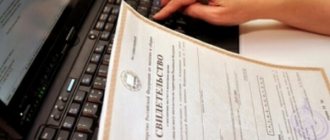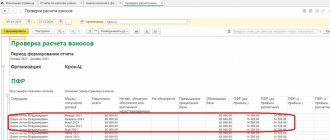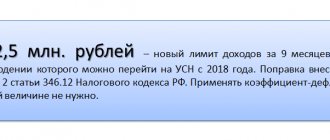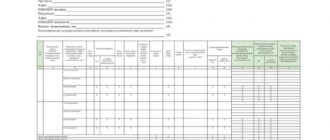Change 3: new procedure for filling out the PP
From 2022, payment orders for transfers of taxes, fees, insurance premiums and other payments to the budget will be filled out in a new way.
Previously, when filling out such PP, individual entrepreneurs, lawyers, notaries, heads of peasant farms and individuals wrote a different code in field 101. Since September 2022, for all listed payers in this field there is one code - 13.
Important! When transferring personal income tax from employee salaries, individual entrepreneurs, lawyers, notaries and heads of peasant farms indicate their standard code 02 in field 01.
IP payments should be clarified. The new regulations apply when transferring payments for yourself (taxes, fees, contributions) and when transferring contributions for employees.
Changes in reporting in 2020
New reports from 2022 - the latest news is as follows. We will see changes to the following forms:
- income tax returns - for the first time, we are reporting in a new way for 2022;
- property tax declarations - we will also submit a new form based on the results of 2022;
- 3-NDFL declarations - also from reporting for 2022;
- calculation of insurance premiums - we present it on a new form for the 1st quarter of 2022.
Download our checklists for completing reports for 2019 and the 4th quarter.
Change 4: single tax payment
From January 1, 2022, a single tax payment will be introduced for individual entrepreneurs and legal entities, which will allow all tax payments to be paid with one payment document without specifying the type of payment. The tax office itself will count the transferred money towards one or another KBK.
Note! A single tax payment is not mandatory for everyone. The right to pay all mandatory contributions to the budget according to the old scheme is retained. In 2022, two budget calculation systems will be in place.
How can an individual entrepreneur switch to tax for the self-employed?
To switch to NAP, it is not necessary to close the individual entrepreneur. There is no need to go to the tax office either, everything is done via the Internet without papers.
Self-employment is registered in one of the following ways:
— Through the “My Tax” application. It is available on Google Play and AppStore;
— In the Payer’s Account, NTD is the same “My Tax”, only on the computer screen;
— Through an authorized bank.
The self-employed person chooses the region of primary activity. 63% of the tax will go to the regional budget, the remaining 37% to the Compulsory Medical Insurance Fund.
Within 24 hours after registering in “My Tax,” the tax office will transfer the individual entrepreneur to the tax for the self-employed. Proof of the transition will be KND Certificate 1122035 from the application with the date of adoption of the new regime.
After the transition, the individual entrepreneur pays only NPD - 4% from sales to individuals and 6% from sales to legal entities and individual entrepreneurs. At first, the rate is even lower - 3 and 4%. This will remain so until the self-employed person exhausts the tax bonus of 10,000 rubles. Other taxes and insurance premiums are canceled - the main thing is to formalize the waiver of special regimes.
Change 5: new simplified taxation regime
From 2022, entrepreneurs in 4 experimental regions (Moscow, Moscow region, Tatarstan and Kaluga region) will be able to switch to the new simplified system if their annual income does not exceed 60 million rubles, the staff employs no more than 5 people, and salaries are paid non-cash.
Payers under such a taxation system are exempt from mandatory social contributions for themselves and for their employees, however, income tax will be increased. Taxpayers on income will pay an 8% rate. Taxpayers on income reduced by expenses - 20%.
Regions cannot reduce these established rates.
Also, in this mode you don’t have to do accounting and submit declarations.
If the experiment turns out to be positive, then the new regime will work in all constituent entities of the Russian Federation from January 1, 2024.
Tax mechanism
We are not talking about the previously widely discussed mode - “USN.online”. It was briefly mentioned in the “Main Directions of Budget, Tax and Customs Tariff Policy for 2022 and the Planning Period of 2023 and 2024” and is being discussed by deputies under bill No. 875583-7.
The developed regime is only for taxpayers from among entrepreneurs and micro and small business organizations . Tax officers will calculate taxes on their own instead of accountants, managers and individual entrepreneurs, so that everything is fair and without errors.
It is expected that the tax rate will be 2-4 percentage points higher than that of the familiar simplified tax system. At the time of this publication, we were talking about 8% and 20%.
The tax increase will be offset by the abolition of insurance contributions , ranging from business contributions to contributions for employees.
In addition to the taxpayer and the tax authority, the participation of banks and fiscal data operators is planned . Based on bank statements and receipts through online cash desks, the tax amount will be calculated (monthly). A tax period of one month will allow you to pay the new tax systematically and regularly.
So far, this description is very reminiscent of the income-generating simplified tax system, but legislators have also provided for the possibility of reducing taxes through business expenses. Like income, they will be collected through online cash register data and non-cash payments through servicing banks.
Vladimir Manzyuk , owner of the “Self-Employed” product of MTS Bank :
“A big advantage and feature of the new regime is the automatic calculation of taxes on the side of the Federal Tax Service. Thanks to this innovation, entrepreneurs will not waste time on calculations. Also, businesses now do not have to be afraid of inspections due to possible errors in calculations.”
All income and expenses will be recorded in your personal account on the Federal Tax Service website.
As for employee salaries, it will also have to be optimized - using salary projects. With their help, it will be possible not only to transfer the salary itself, but also to withhold and pay personal income tax to the budget. Only now the bank will act as a tax agent , guided by the received salary slips.
But what if you have contracts not only with employees, but also with third-party performers and contractors? It will be most profitable to work with the self-employed.
- Firstly, in order to accept payments to such performers as expenses, the relationship with them must be formalized . It will no longer be profitable to issue payments in cash and without documents.
- Secondly, transfers will have to be made through a bank, self-employed people, because... They have official status and are not afraid to accept payments by card .
- Thirdly, in order to organize document flow with the self-employed, you can use special services, for example, YouDo Business. There is no need to wait for the necessary documents or signed agreement to be handed over to you.
By the way, YouDo Business also allows you to find self-employed people in the field you need and automates calculations, making it easy to work with performers even remotely.
- Fourthly, given that insurance premiums for the new regime are going to be abolished, the line between working with an employee under an employment contract and the self-employed is almost erased. Even personal income tax will be a concern for banks. Therefore, if previously you were afraid to hire self-employed people even for temporary projects, for fear of reclassifying their contracts as employment contracts, now it will be virtually pointless - after all, it will no longer be possible to collect insurance premiums (and this is the main point of claims of inspectors) from the employer.
Change 7: regarding VAT
In relation to VAT, two innovations will also apply:
●
Entrepreneurs from the catering sector whose total income for the previous year did not exceed 2 billion rubles, and the share of income from catering services was at least 70%, will be able to avoid paying VAT.
From 2024, one more condition will be added - to be exempt from VAT, individual entrepreneurs will have to pay their employees a salary no lower than the industry average.
The change is spelled out in more detail in clause 2 of Art. 2, part 4 art. 10 of the Law of July 2, 2021 No. 305-FZ.
●
The list of goods on the sale of which VAT is charged on the difference between prices has been expanded.
For a detailed acquaintance, you should read Art. 1, paragraph 2, art. 2 of the Law of April 30, 2021 No. 103-FZ.
Individual entrepreneurs pay social insurance contributions voluntarily
A self-employed individual entrepreneur has the opportunity to buy insurance in case of illness and maternity leave. Self-employed individuals cannot do this - Letter of the Social Insurance Fund No. 02-09-11/06-04-4346.
For insurance, an individual entrepreneur submits an application to the Social Insurance Fund of his city. You can take it in person or send it through State Services. The cost of a year of insurance in 2022 is 4,451.62 rubles.
The insurance will only start working next year. That is, if you pay contributions this year, you can receive maternity benefits no earlier than January 1 of the next year. Benefits will be calculated based on the minimum wage, and not on the amount of real income.
Change 8: changes to the simplified tax system
There are also three changes to the simplified tax system for taxpayers:
●
a new declaration form, and the declaration for 2022 will have to be submitted on it;
●
the list of expenses for the simplified tax system has been expanded, now it includes the costs of ensuring safety measures and maintaining the premises and equipment of health centers and expenses for the purchase of medical products for the diagnosis and treatment of coronavirus;
●
The Ministry of Finance also allowed the inclusion of employee salaries for non-working days as expenses (more details in the Letter of the Ministry of Finance dated June 16, 2021 No. 03-11-06/2/47346).
Individual entrepreneur is obliged to refuse simplification, patent and agricultural tax
The tax for self-employed cannot be combined with other special regimes. The entrepreneur must abandon the simplified tax system, unified agricultural tax and patent. All activities of individual entrepreneurs as a whole are transferred to NPD. For example, it will not be possible to pay NAP for the provision of hairdresser services, and leave the sale of shampoos to the simplified tax system.
If the individual entrepreneur was on a common system before the transition, no refusals need to be issued.
How to refuse the simplified tax system and unified agricultural tax
You have a month to waive the simplified tax system and unified agricultural tax after registering self-employment.
If you meet the deadline, the special regime will end from the date of registration. If you are late, the tax office will cancel the transition to the NAP, and the tax will have to be paid according to the old special regime.
To refuse the special regime, notifications are submitted to the tax office:
— For the simplified tax system according to the form according to KND 1150024:
— For Unified Agricultural Tax in the form according to KND 1150027.
The titles of the notifications say that the individual entrepreneur declares the termination of activities. There is no need to worry: these forms for the transition to the NAP were recommended by the Ministry of Finance - Letter No. SD-4-3/ [email protected]
Notifications are sent through your Personal Account, brought in person to your district inspectorate, or sent by registered mail.
Then, by the 25th of the next month, the individual entrepreneur submits a return for the current year and pays tax.
It may turn out that the entrepreneur will receive payment from clients for goods or services that he supplied before switching to self-employment. Such payment is included in income under the old special regime, and not under the new NAP.
How to renounce a patent
The patent must be renounced 10 days before registering self-employment. Or wait until the end of the period - Letter of the Ministry of Finance No. 03-11-11/94279.
Article: how to terminate activities under a patent
New form of adjustment invoice.
From October 1, 2022, entrepreneurs will need to issue an adjustment invoice only using the new form; until October 2021, the Federal Tax Service allowed the use of both the old and new versions of the document. Electronic adjustment invoices using the old inspection format will be accepted until the end of 2024. When selling traceable goods, adjustment invoices are drawn up only in electronic form, and for sales of untraceable goods, works, services or property rights - on paper or in electronic form (clauses 1 and 1.1 of Article 169 of the Tax Code). Main changes:
- a single adjustment invoice reflects information from all invoices for which this document is compiled;
- in this case, each item is registered separately, and in column 1 the entry number from the initial invoice is indicated;
- the same procedure is used for invoices indicating goods, works, services with the same name and price.
Exchange electronic invoices with counterparties according to the new rules.
Changing the procedure for purchasing goods and services from small and medium-sized businesses.
On the first day of October, Decree of the Government of the Russian Federation dated June 19, 2021 No. 937 “On amendments to paragraphs 8 and 19 of the Regulations on the specifics of the participation of small and medium-sized businesses in the procurement of goods, works, services by certain types of legal entities, the annual volume of such procurement and the procedure for calculating the specified volume.”
We increased the maximum price of contracts for the purchase of goods and services from SMEs. The maximum contract price for the purchase by state companies of goods and services from small and medium-sized entrepreneurs will be increased to 800 million rubles, thus increasing by 400 million rubles.
It is important to pay for the contract with SMEs within no more than 15 working days from the date of signing the document on acceptance of the work, service or goods under the contract. Payment is made in the same way if the counterparty’s work under the contract is accepted. Such deadlines are provided only for purchases from small and medium-sized businesses.
If the purchase contract was concluded after a tender held on a general basis, the payment terms described above may not apply.
Tools for working with procurement Flexible search options from 230 sources. We help suppliers work with purchases, monitor changes in them, analyze customers and competitors.
Try it for free.







